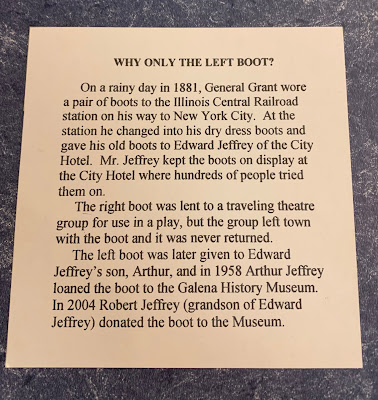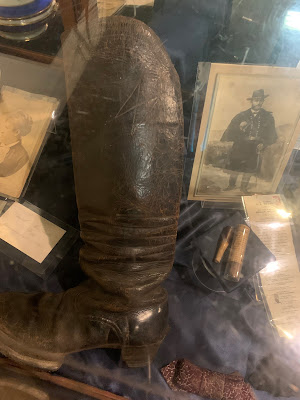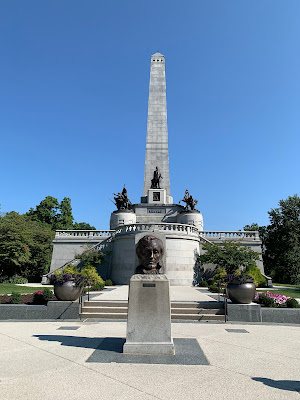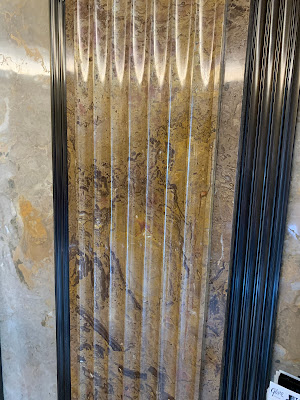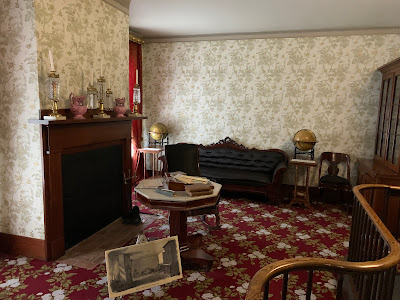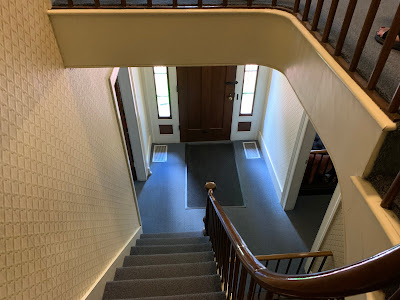We moved on to a little town in Wisconsin on the border of Wisconsin, Illinois, and Iowa because we had a few things nearby to visit. First stop Galena, Illinois. Population in 2020 was 3308.
Galena was the site of the first major mineral rush in the United States. By 1828, the population was estimated at 10,000, rivaling the population of Chicago at the time. Galena developed as the largest steamboat hub on the Mississippi River north of St. Louis. And because you know we had a reason to visit, Galena was the home of Ulysses S. Grant and eight other Civil War generals. Today, the city is a tourist destination known for its history, architecture, and resorts.
Ulysses S. Grant moved to Galena with his family in 1860 so that he could work in the family leather business. After serving in the U.S. Army for 15 years and resigning his commission, Grant failed at several business enterprises. In desperation, he agreed to take a job offer from his father who owned a leather goods business in Galena managed by his brother.
While not the house (now museum) that Ulysses S. Grant lived in, it gives you an idea of the architecture from 1868.
We walked in the door and the guide quickly ushered us into a room as they were just starting the movie "hosted" by Ulysses and Julia Grant holograms which was very informative. Because it was dark when we took our seats we hadn't had an opportunity to look around the room so we lagged behind in order to spend some time.
The Grant Family, 1867
Julia Grant
Replica of the dress Julia Grant was wearing in the portrait above
Grant's arrival at Chattanooga is pictured below. Following Grant's victories at Vicksburg and Chattanooga, he was suddenly revered in the North as a second George Washington. This portrait shows Grant in a pose similar to Washington in a John Trumbull painting of 1780.
President Lincoln, who had not yet met Grant, made a point of viewing this painting while it was displayed at the U.S. Capitol.
General Grant on the Battlefield
John Antrobus, Oil on Canvas
1863-4
After talking with the guide for a bit, we climbed the stairs to visit the History & Military Museum.
An interesting fact about Galena is that it was the home of nine Generals in the Civil War.
Ulysses S. Grant
John Rawlins, Augustus Chetlain
Jasper Maltby, Ely Parker, John Duer
William Rowley, John C. Smith, John E. Smith
Many wonder how a small town like Galena could have been home to nine Civil War Generals, not the least of whom was Ulysses S. Grant. Some contributing factors: In 1861 Galena was one of Illinois' largest and most influential cities with a population of nearly 12,00 and Galena had been the largest river boat port north of St. Louis for 20 years and a gateway for settlers moving north and west.
In addition to nine Generals, Galena was also the home to Congressman Elihu Washburne, the senior Republican in the U.S. House of Representatives and one of its most influential members. He was instrumental in furthering the military, and later political, career of U.S. Grant.
Many influential individuals in American history visited Galena over the years.
Theodore Roosevelt, Frederick Douglas, Samuel Clemens AKA Mark Twain, Ralph Waldo Emerson
Elizabeth Cady Stanton, Stephen Douglas, Abraham Lincoln
Herman Melville, Robert E. Lee, Susan B. Anthony
Jasper Maltby, one of the Generals above, was also a gun maker - a few of his guns below.
This was an interesting display.
The left boot
While reproductions are interesting, I just love seeing original artifacts.
A great photo of General Grant on the battlefield.
Look at this original signature of Ulysses S. Grant
A lot of lead mining in Galena and there was a display in the museum of an actual vertical mine as the home was built on top of the mine in 1858.
That's a long way down there
By far the most significant artifact in the museum was this portrait, Peace in Union, by Thomas Nast from April 9, 1895. This painting is the original 9'x12' and we were surprised that it is not in a secure, climate controlled environment.
Nearly every American school child has seen the painting of Robert E. Lee's surrender to Ulysses S. Grant at Appomattox. The image has graced the pages of American history textbooks for generations. Many might think that the original canvas is at the Smithsonian but we learned that the Smithsonian doesn't even own the painting but rather the museum here in Galena.
Upon his commissioning, Nast began two years of intense research on the surrender and the people who were present. He read up on Grant's generals to portray them as accurately as possible in his painting. Some show relief in their tired faces for the end of the long and bloody war. Others show reverence for Grant and his leadership that brought the conflict to a close. Still others show contempt for Lee and his confederacy of rebels and traitors.
Representatives from the Smithsonian have tried at least three times to convince the Galena Historical Society to sell the oil painting to them. Every visit to the small town has been unsuccessful though. No amount of money will allow the people of Galena to part with the painting. Although Grant and his family lived in Galena for only a year before the start of the Civil War, he would consider it home for the remainder of his life and the town of Galena is extremely proud of that fact.
This key shows who is who in the painting.
And with that we walked through the historic town and saw this interesting building.
There were some fascinating events in this hotel.
We took a look inside - beautiful!
Tomorrow we go to a bucket list item for Ron - stay tuned!













